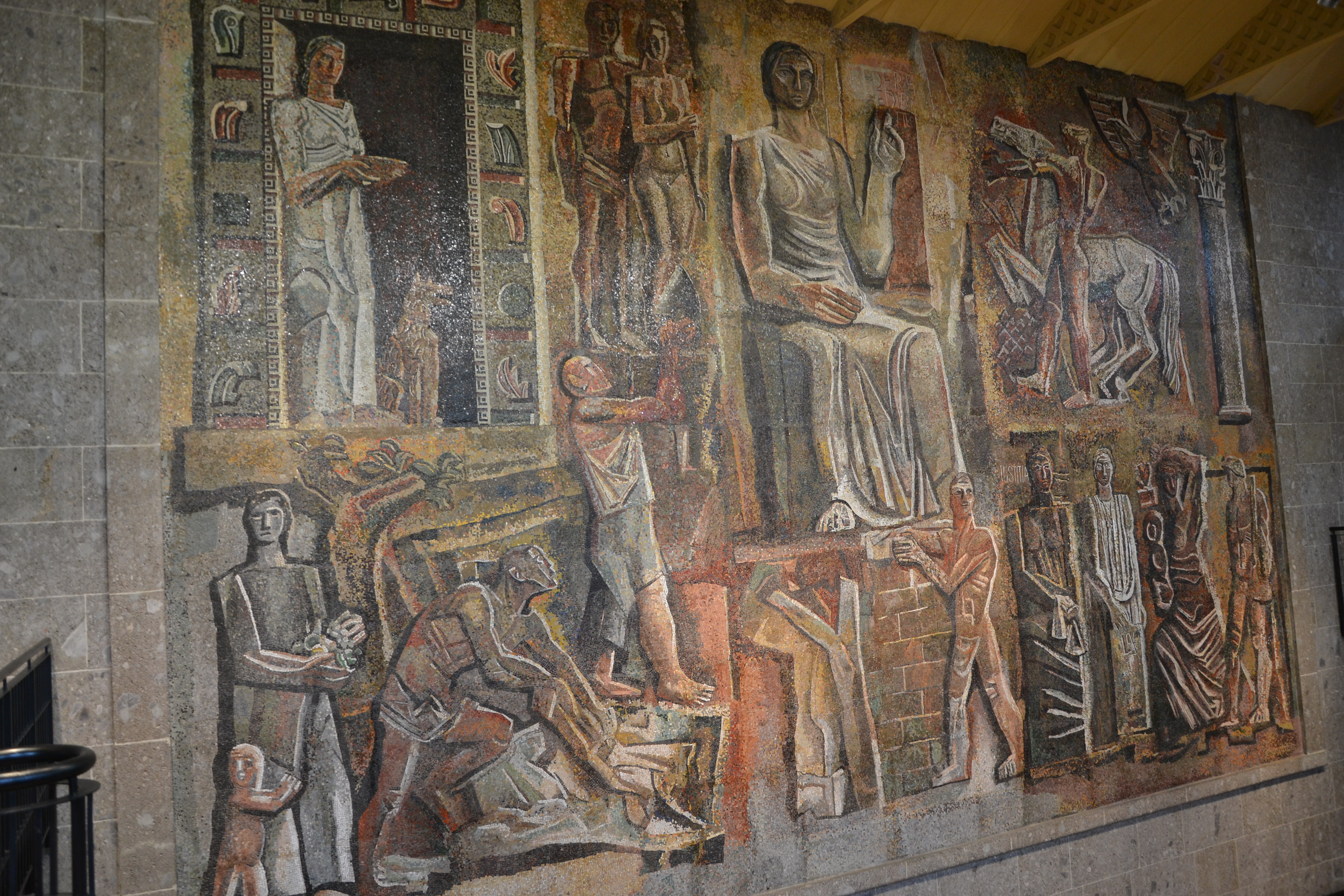Pictured: A mosaic titled Il lavoro fascista, from the Palazzo dell’Informazione in Milan.
There is no denying that Fascism proved immensely valuable to the bourgeoisie, but if you ever encountered neofascist intellectuals (and yes, such neofascists do exist) they often take it a step further and claim that Fascism benefitted the proletariat as well. You’ll be very tempted to immediately conclude that their claims are bullshit, but you probably won’t know how to formally and adequately respond to them either.
If you are willing to assume good faith, the data that they cite supporting Fascism can look impressive indeed. But like a magic trick, once you examine the process the results shall suddenly become far less impressive. A good example of this is how the Fascists handled unemployment. Quoting Daniel Guerin’s Fascism and Big Business, pages 261–2:
The effect on wage levels of the so‐called “campaign against unemployment” must also be taken into account. The fascist state, in fact, economizes on unemployment relief by making workers with jobs, who are transformed into partially unemployed, pay for the assistance to the jobless.
For instance, in November, 1934, the forty hour week was introduced into industry without maintaining weekly wages. Lavoro Fascista confessed that “reduction of work will mean a considerable sacrifice for the workers already employed.”45 Compensation is provided only for workers who are heads of large families, but this supplement is taken from other workers who, in addition to the cut in their weekly wages, are deprived of another 1 percent of their pay for the “family allowances.”
In certain industries, work is rotated, the employees working one week out of two, for instance, which further reduces their weekly income by half.46
Another expedient was adopted in November, 1934, when an agreement was signed between the employers’ association and the “unions” providing that women and young men can be dismissed from their jobs and replaced by adult unemployed men. But the employers pay the newly hired workers only the starvation wages previously paid the young men and women, and the measure helps to lower wage standards.
Finally, the unemployed who are given jobs on public works are paid at lower rates on the pretext that these works have “an emergency character as unemployment relief,” and this too serves to depress wage levels.
A similar pattern was visible in the Third Reich. Pages 263–4:
The effect of the so‐called “fight against unemployment” on wage levels must also be taken into consideration. The [Third Reich], finding itself faced with widespread unemployment, succeeds in economizing on unemployment relief by making the workers with jobs, transformed into partially unemployed, pay for the relief of the jobless.
The employers are forced by the public authorities or the party to hire more labor than they really need, but the latter make up for this additional burden either by reducing all wages or by shortening the working hours of each worker.
Another expedient is to dismiss women and young men from their jobs and replace them by adult unemployed men. A decree of August 28, 1934, gave the “labor offices” full power to deprive women and unmarried men less than twenty‐five years old of their employment.
But the employers pay the older workers hired in their place only the starvation wages previously paid the women and youngsters. By virtue of this decree, 130,000 workers under twenty‐five were discharged. (Later the decree lost its importance due to the scarcity of labor as a result of the intensified rearmament program. In 1937, 370,000 women went back to work.)
Finally, the general level of wages is lowered because the unemployed put to work on various public work projects receive ridiculously low pay. The workers assigned to auxiliary works (about 400,000 in 1934) receive as their entire compensation the unemployment allowance plus some relief in the form of commodities. Workers assigned to motor highway construction (nearly half a million in March, 1936)—although this is “independent work” and not emergency work undertaken to combat unemployment—are paid, with the complicity of the labor curators, at a rate lower than the prevailing wage for laborers.
The workers conscripted in 1938 for work on fortifications are not paid the wages they received on their former jobs. The young men conscripted in the labor service (about 250,000) and doing heavy work, receive merely the soldier’s pay—that is, 50 pfennigs a day. Young girls forced to serve a domestic apprenticeship of a year in a family or on a farm54 have to toil as “maids of all work” without their masters being compelled to pay them a fixed wage.
In the beginning of May, 1936, [Berlin] put “cheap labor” at the disposal of the Ruhr industrialists in the form of unemployed, paid from 1.50 marks to 2 marks a day. “This labor,” the Petit Parisien stated on May 4, “would make it possible […] to bring pressure on the wage levels of other categories of workers.”
(Emphasis added in all cases.)
It is worth noting that a significant percentage of unemployment’s reduction was due to preparation for war, which can be very good for capitalist economies, the Fascist economies most definitely included. War creates a high demand for jobs, most obviously in infantry, but it also demands jobs in manufacture: the firearms, the munitions, the vehicles, the technologies, the uniforms—all of those need manufacturers, so they generate jobs.
So it would be a hyperbole to conclude that the Fascist empires reduced their unemployment simply by “cheating” like this. These were factors, but another important factor—as hinted above by the rearmament—was bellicism. This reliance on warfare for economic stimulation was a problem that the bourgeoisie has never even contemplated solving, and thus it remains a feature in the status quo’s neoliberal economies. The difference is that while the Fascist economies soon devoted theirselves to total warfare, the present capitalist economies have not done so (at least not yet).
1876: Louis Rudolph Franz Schlegelberger, tate Secretary in the German Reich Ministry of Justice, worsened life with his presence.
1880: Dominikus Böhm, Axis architect, started his life.
1902: Robert Eberan von Eberhorst, Axis engineer, was born.
1936: Berlin and Tōkyō signed the final, secret text on the Anti‐Comintern Pact, and Berlin and Rome signed the Italo‐German Protocol. Berlin likewise ordered the Condor Legion to Spain to fight for the Nationalists.
1940 Adolf Schicklgruber and Francisco Franco met at Hendaye to discuss the possibility of Spain officially joining the Axis.
1941: The Third Reich prohibited Jews from emigrating, including in its occupied territories.
1942: The Allies commenced the Second Battle of El Alamein, which proved to be the key turning point in the North African campaign, and the Battle for Henderson Field began on Guadalcanal.
1944: The Battle of Leyte Gulf commenced.
It’s just amazing how the liberals always manage to project onto communism what actually happens under capitalism. This tracks pretty closely to what I was taught in high school about the Soviet Union. I’m sure that’s no accident though.
This is nice to know. Arguing against this position seems like a bit of a mug’s game, though. I think you might be arguing within a besides-the-point framing they want you to waste time & energy arguing.
God damnit





